Serving 2,121 students in grades 9-12, Tampa Bay Tech High School ranks in the top 50% of all schools in Florida for overall test scores (math proficiency is top 50%, and reading proficiency is top 50%).
The percentage of students achieving proficiency in math is 56% (which is higher than the Florida state average of 52%). The percentage of students achieving proficiency in reading/language arts is 55% (which is higher than the Florida state average of 52%).
The student:teacher ratio of 23:1 is higher than the Florida state level of 17:1.
Minority enrollment is 90% of the student body (majority Black), which is higher than the Florida state average of 65% (majority Hispanic and Black).
Quick Stats (2025)
- School Type: Magnet School
- Grades: 9-12
- Enrollment: 2,121 students
- Student:Teacher Ratio: 23:1
- Minority Enrollment: 90%
- Graduation Rate: 98% (Top 5% in FL)
- Overall Testing Rank: Top 50%
- Math Proficiency: 56% (Top 50%)
- Reading Proficiency: 55% (Top 50%)
- Science Proficiency: 71% (Top 20%)
- Source: National Center for Education Statistics (NCES), FL Dept. of Education
Top Rankings
Tampa Bay Tech High School ranks among the top 20% of public schools in Florida for:
Category
Attribute
Science Proficiency
Graduation Rate
School Overview
Tampa Bay Tech High School's student population of 2,121 students has stayed relatively flat over five school years.
The teacher population of 93 teachers has declined by 6% over five school years.
School Type
Grades Offered
Grades 9-12
Total Students
2,121 students
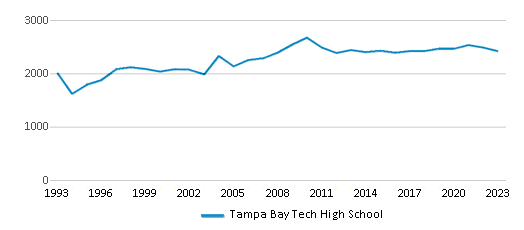
Gender %
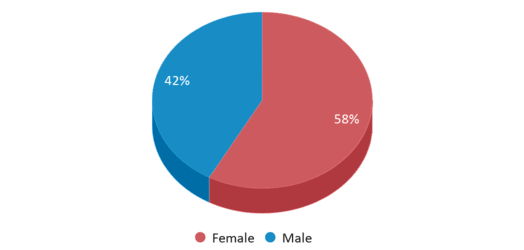
Total Classroom Teachers
93 teachers
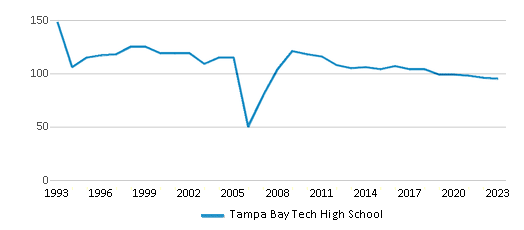
Students by Grade
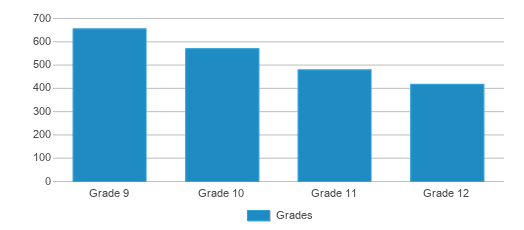
School Rankings
Tampa Bay Tech High School ranks within the top 50% of all 3,704 schools in Florida (based off of combined math and reading proficiency testing data).
The diversity score of Tampa Bay Tech High School is 0.63, which is less than the diversity score at state average of 0.70. The school's diversity has stayed relatively flat over five school years.
Overall Testing Rank
#1391 out of 3704 schools
(Top 50%)
(Top 50%)
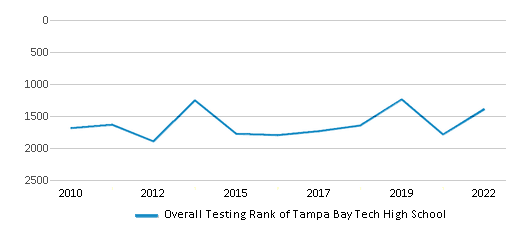
Math Test Scores (% Proficient)
56%
52%
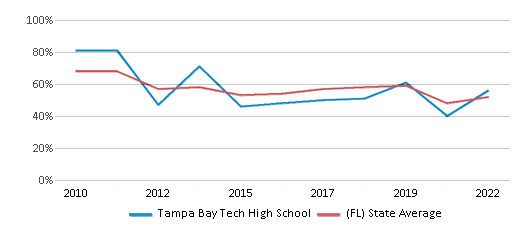
Reading/Language Arts Test Scores (% Proficient)
55%
52%
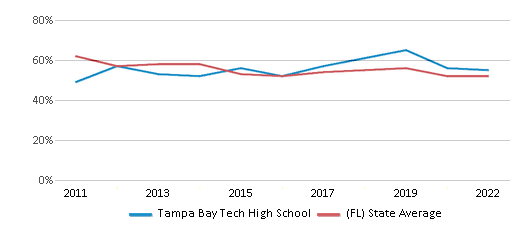
Science Test Scores (% Proficient)
71%
52%
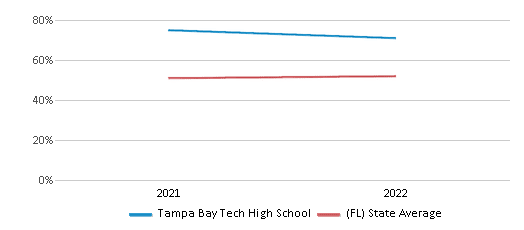
Student : Teacher Ratio
23:1
17:1

American Indian
n/a
n/a
Asian
3%
3%
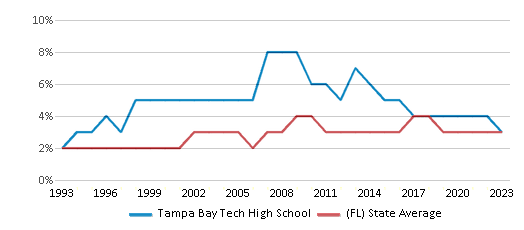
Hispanic
29%
37%
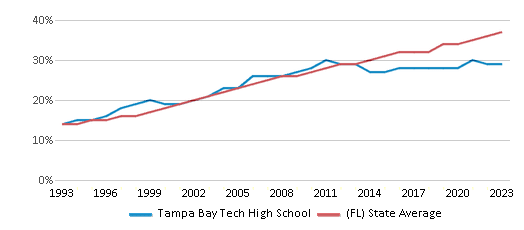
Black
53%
21%
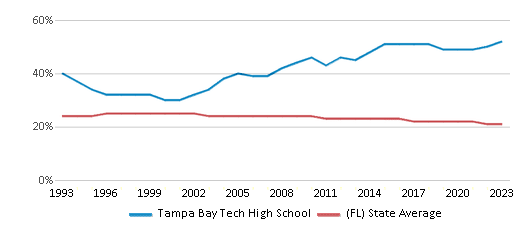
White
10%
35%
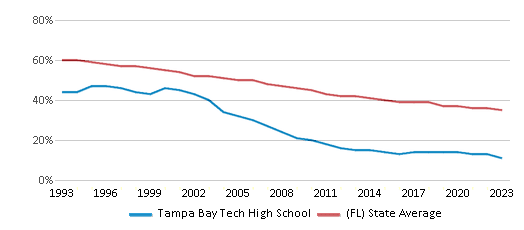
Hawaiian
n/a
n/a
Two or more races
5%
4%
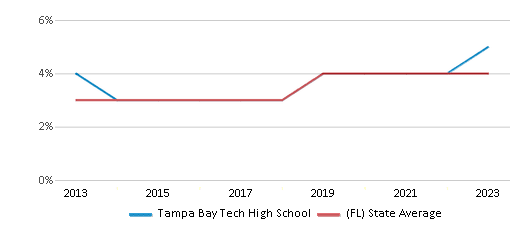
All Ethnic Groups
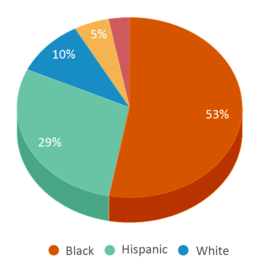
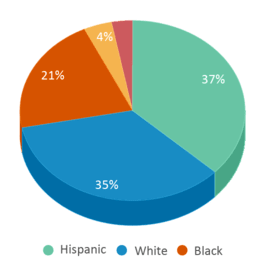
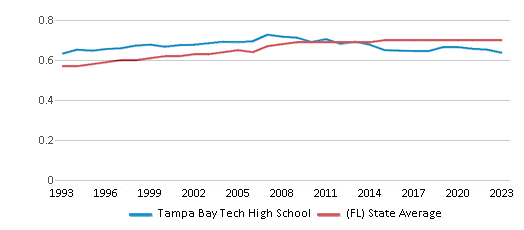
Graduation Rate
98%
87%
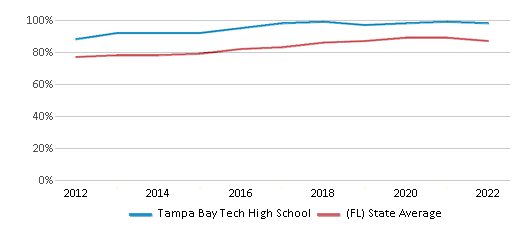
Participates in the National School Lunch Program (NSLP)
Yes
Eligible for Free Lunch
53%
47%
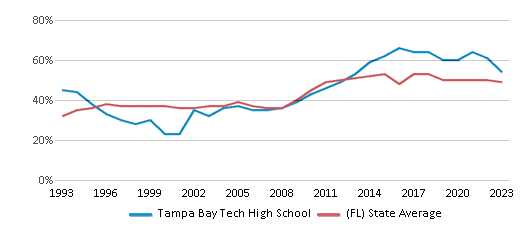
Eligible for Reduced Lunch
5%
4%
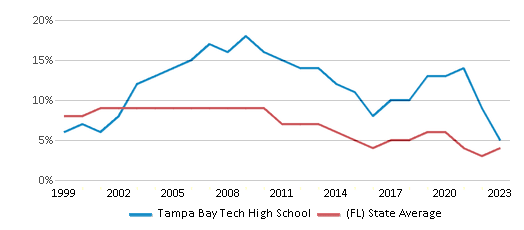
School Statewide Testing
School District Name
Source: National Center for Education Statistics (NCES), FL Dept. of Education
Profile last updated: 02/09/2025
Frequently Asked Questions
What is Tampa Bay Tech High School's ranking?
Tampa Bay Tech High School is ranked #1391 out of 3,704 schools, which ranks it among the top 50% of public schools in Florida.
What percent of students have achieved state testing proficiency in math and reading?
56% of students have achieved math proficiency (compared to the 52% FL state average), while 55% of students have achieved reading proficiency (compared to the 52% FL state average).
What is the graduation rate of Tampa Bay Tech High School?
The graduation rate of Tampa Bay Tech High School is 98%, which is higher than the Florida state average of 87%.
How many students attend Tampa Bay Tech High School?
2,121 students attend Tampa Bay Tech High School.
What is the racial composition of the student body?
53% of Tampa Bay Tech High School students are Black, 29% of students are Hispanic, 10% of students are White, 5% of students are Two or more races, and 3% of students are Asian.
What is the student:teacher ratio of Tampa Bay Tech High School?
Tampa Bay Tech High School has a student ration of 23:1, which is higher than the Florida state average of 17:1.
What grades does Tampa Bay Tech High School offer ?
Tampa Bay Tech High School offers enrollment in grades 9-12
What school district is Tampa Bay Tech High School part of?
Tampa Bay Tech High School is part of Hillsborough School District.
School Calendar
View the Tampa Bay Tech High School yearly calendar below. Note key dates such as:
Event
Date
Spring Break/Non-Student Days
March 17, 2025 (Monday)
Seniors' Last Day
May 21, 2025 (Wednesday)
Last Day of School/End of 4th Grading Period (end of 2nd Semester)
May 30, 2025 (Friday)
Students' First Day of School
August 11, 2025 (Monday)
Fall Break/Non-Student Days*
November 24, 2025 (Monday)
School Reviews
5 3/22/2014
Excellent school with instructors that work to prepare students for college and careers. Students pick up very valuable skills in the Technical shop programs and health academy and have an edge for kids that attend the other high schools. There are Spanish speaking teachers as well.
Review Tampa Bay Tech High School. Reviews should be a few sentences in length. Please include any comments on:
- Quality of academic programs, teachers, and facilities
- Availability of music, art, sports and other extracurricular activities
Recent Articles

What Is A Charter School?
Explore the world of charter schools in this comprehensive guide. Learn about their history, how they operate, and the pros and cons of this educational innovation. Discover key facts about charter schools, including admission policies, demographics, and funding, as well as what to look for when considering a charter school for your child.

10 Reasons Why High School Sports Benefit Students
Discover the 10 compelling reasons why high school sports are beneficial for students. This comprehensive article explores how athletics enhance academic performance, foster personal growth, and develop crucial life skills. From improved fitness and time management to leadership development and community representation, learn why participating in high school sports can be a game-changer for students' overall success and well-being.

February 05, 2025
Understanding the U.S. Department of Education: Structure, Impact, and EvolutionWe explore how the Department of Education shapes American education, from its cabinet-level leadership to its impact on millions of students, written for general audiences seeking clarity on this vital institution.









